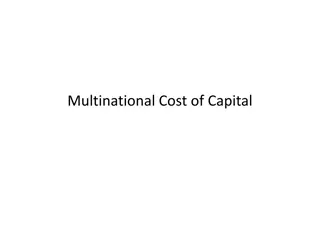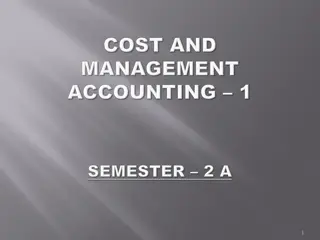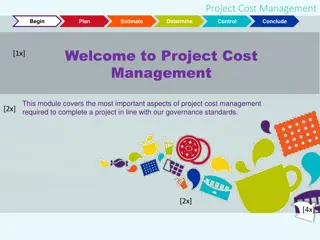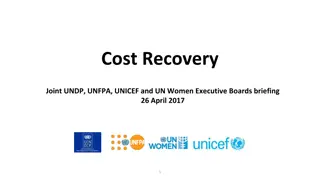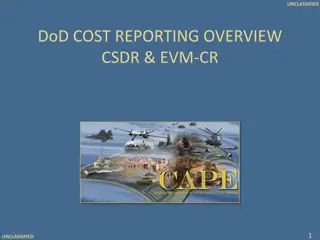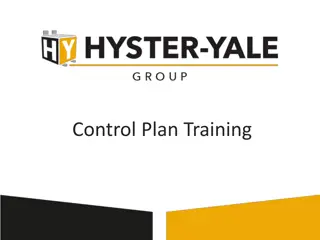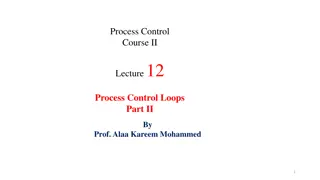
Project Cost Control Strategies for Effective Management
Explore the integration of cost and schedule, key indicators in performance measurement, cost forecasting equations, and more in this insightful lecture on project cost control. Learn how to identify excessive costs, forecast total job costs, and update company databases for effective cost control strategies.
Download Presentation

Please find below an Image/Link to download the presentation.
The content on the website is provided AS IS for your information and personal use only. It may not be sold, licensed, or shared on other websites without obtaining consent from the author. If you encounter any issues during the download, it is possible that the publisher has removed the file from their server.
You are allowed to download the files provided on this website for personal or commercial use, subject to the condition that they are used lawfully. All files are the property of their respective owners.
The content on the website is provided AS IS for your information and personal use only. It may not be sold, licensed, or shared on other websites without obtaining consent from the author.
E N D
Presentation Transcript
ENGINEERING MANAGEMENT (GE 404) 1 LECTURE # LECTURE #12 Project Cost-Control 12 May 29, 2025 GE 404 (Engineering Management)
Contents 2 Objectives of the present lecture Integration of cost and schedule Aim of project cost control system Cost control Three Key indicators in performance measurement Performance equations Cost forecasting equations Problems Further reading May 29, 2025 GE 404 (Engineering Management)
Objectives of the Present lecture 3 To discuss key indicators in performance measurement of a project To learn how to estimate and forecast different types of costs May 29, 2025 GE 404 (Engineering Management)
Integration of Cost and Schedule 4 The integration of cost and schedule control systems is of natural interest to construction professionals, because the true status of a project can only be assessed if both cost and schedule data are examined in conjunction with one another Example: A project may appear to be well under budget based on the amount of money spent to date compared to what was projected. However, this figure alone could be very misleading; costs may be very low because the project is well behind the schedule. Thus it is necessary to know what actual project costs are relative to expected costs while knowing where the project is on a time basis. The critical path method (CPM) system can also be used as a cost-monitoring system In the1960s, U.S. defense agencies combined guides and requirements related to integration of cost and schedule data into a single system May 29, 2025 GE 404 (Engineering Management)
Aim of Project Cost Control System 5 To identify those work types having excessive costs and to give an indication of how serious those overruns are To forecast the final total job cost To indicate the trend for each cost code, that is, whether the unit cost involved has been increasing or decreasing (evaluation of the effectiveness of cost reduction efforts) To update the database of the company that will be used to estimate future works May 29, 2025 GE 404 (Engineering Management)
Cost Control 6 The cost estimate prepared for the project during the bidding process is the basis for cost control Cost control for an engineering project is limited to the cost of labor, equipment, materials and site overheads Control of cost and time should be linked together May 29, 2025 GE 404 (Engineering Management)
Three Key Indicators in Performance Measurement 7 Budgeted Cost of Work Scheduled (BCWS) Budgeted Cost of Work Performed (BCWP) Actual Cost of Work Performed (ACWP) May 29, 2025 GE 404 (Engineering Management)
BCWS 8 BCWS is the budgeted amount of cost of the work scheduled to be accomplished in a given time period This can be referred to as planned value of work to be accomplished [PV] May 29, 2025 GE 404 (Engineering Management)
BCWP 9 BCWP is the budgeted amount of cost for the work completed in a given time period. Schedule Variance, SV This can be referred to as earned value of work accomplished [EV] BCWP SV=BCWP-BCWS Project Cost (SR) How to calculate BCWP Budgeted cost for work performed (BCWP) = Earned value of an activity = Percent completed for the activity the activity budget BCWS Time Now Time Percent completed for an activity = [(Projected duration duration) / Projected duration] 100 SV>0: ahead of schedule SV<0: behind schedule Remaining May 29, 2025 GE 404 (Engineering Management)
ACWP 10 ACWP is the amount reported as actually spent in completing the particular work within a given time period Cost variance, CV accomplished ACWP CV=BCWP-ACWP Project Cost (SR) BCWP Time Now Time CV>0: under budget CV<0: over budget May 29, 2025 GE 404 (Engineering Management)
Performance Equations Symbol Definition Budgeted Cost of Work Scheduled planned value of work to be accomplished (BCWS) [PV] Budgeted Cost of Work Performed earned value of work accomplished (BCWP) [EV] Actual Cost of Work Performed (ACWP) [AC] Cost Performance Under budget > 0 Work performed cost > Actual cost BCWP Within budget Cost Variance CV = BCWP-ACWP = 0 Work performed cost = Actual cost ACWP Over budget < 0 Work performed cost < Actual cost Cost Performance Under budget > 1 Work performed cost > Actual cost BCWP Within budget Cost Performance Index CPI = BCWP/ACWP = 1 Work performed cost = Actual cost ACWP Over budget < 1 Work performed cost < Actual cost Cost Performance Under run > 0 Performed cost > Earned BCWP ( (BCWP ACWP) BCWP % Cost Overrun/ Underrun on run = 0 Performed cost = Earned ACWP Over run < 0 Performed cost < Earned The Cost Overrun curve is a plot of the calculated percent ver- or underrun at any given time.
Performance Equations (Contd.) 12 Schedule (Time) Performance Ahead schedule > 0 Work performed > Work scheduled BCWP On schedule Schedule Performance Variance SV = BCWP-BCWS = 0 Work performed = Work scheduled BCWS Behind scheduke < 0 Work performed < Work scheduled Schedule (Time) Performance Ahead schedule > 1 Work performed > Work scheduled BCWP On schedule Schedule Performance Index SPI = BCWP/BCWS = 1 Work performed = Work scheduled BCWS Behind scheduke < 1 Work performed < Work scheduled May 29, 2025 GE 404 (Engineering Management)
BCWP, BCWS and ACWP 13 May 29, 2025 GE 404 (Engineering Management)
Cost Forecasting Equations 14 Budget Cost At Completion BAC = BCWSend ACWP Or = EAC BAC date to BCWP date to Estimated Cost At Completion ( ) BAC - BCWP = + EAC ACWP date to date to CPI this period Estimate to Completion ETC = EAC - ACWP Variance from original budget VB = EAC - BAC May 29, 2025 GE 404 (Engineering Management)
BCWS [PV], BCWP [EV], and ACWP[AC] S-curves 15 May 29, 2025 GE 404 (Engineering Management)
Contd. 16 May 29, 2025 GE 404 (Engineering Management)
Problem-1 D A C F H 0 1 2 4 5 For the following network, compute the early and late start cumulative costs for the project, and draw the conclusion. E G B 3 Duration Week 2 4 5 6 4 2 3 3 ES Time 0 0 2 2 7 7 11 9 LS Time 0 3 2 5 7 7 11 11 Cost per week, SR 400 200 300 400 350 200 300 200 Activity Depend on A A B, C B, C E D, F A B C D E F G H 17 May 29, 2025 GE 404 (Engineering Management)
Solution (Cost based on ES) 18 A (400) B (200) C (300) D (400) E (350) F (200) G (300) H (200) week Cost Cum. 1 2 3 4 5 6 7 8 9 10 11 12 13 14 600 600 900 900 700 700 700 950 550 550 550 500 300 300 600 1200 2100 3000 3700 4400 5100 6050 6600 7150 7700 8200 8500 8800 May 29, 2025 GE 404 (Engineering Management)
Solution (Contd.) (Cost based on LS) 19 A (400) B (200) C (300) D (400) E (350) F (200) G (300) H (200) week Cost Cum. 1 2 3 4 5 6 7 8 9 10 11 12 13 14 400 400 300 500 500 900 900 950 950 750 750 500 500 500 400 800 1100 1600 2100 3000 3900 4850 5800 6550 7300 7800 8300 8800 May 29, 2025 GE 404 (Engineering Management)
Conclusion 20 10000 9000 8000 Cummulative Cost (SR) 7000 6000 5000 4000 3000 Cumulative Cost based on ES 2000 Cumulative Cost based on LS 1000 0 0 2 4 6 8 10 12 14 16 Weeks The above curves show that although the final cumulative cost is the same at the end of the project but the cumulative cost at the early age of project is substantially lesser in LS based schedule. May 29, 2025 GE 404 (Engineering Management)
Problem-2 21 You are required to submit a progress report to your boss about the performance of an activity of a project. The activity s information as follow: number of units is (800); unit cost is SR 12 ; and planned productivity is 100 unit/day. Performances were measured at the end of day (3) and day (6) as follows: Period Cost at this period Number of units finished 250 320 day 0 to day 3 SR 3,600 day 4 to day 6 SR 3,700 a) Calculate BCWP, ACWP, and BCWS for (i) each of the two periods (i.e. day 0 to day 3 and day 4 to day 6) and (ii) to date (i.e. day 0 to day 3 and day 0 to day 6). b) Draw a graphical report for ACWP and BCWP. Also calculate estimated cost at completion and days by which activity is ahead or behind. May 29, 2025 GE 404 (Engineering Management)
SV=BCWP-BCWS CV = BCWP-ACWP Solution part a(i) 22 0-3 period BCWP= (250 12)=3000 ACWP= 3600 (Given) BCWS= (300 12)=3600 CV = BCWP-ACWP=3000-3600=-600 (over budget) SV = BCWP-BCWS=3000-3600=-600 (Behind schedule) Following the above procedure the above parameters can also be estimated for 4-6 period Summary Period BCWP ACWP BCWS Variance Cost STATUS Sch. Schedule -600 Behind 240 Cost 0 - 3 4 - 6 SR 3000 SR 3600 SR 3600 -600 SR 3840 SR 3700 SR 3600 Over Bud. under Bud. 140 Ahead May 29, 2025 GE 404 (Engineering Management)
SV=BCWP-BCWS CV = BCWP-ACWP Solution part a(ii) 23 At 3rd day, BCWP= (250 12)=3000 BCWS= (300 12)=3600 ACWPto date BCWP to date BAC=3600/3000 (800 12)=11,520 BAC =BCWSend = (800 12) EAC = No. of units behind = 300-250=50 which will require =50/100 = 0.5 day to finish At 6th day, ACWPto date BCWP to date BAC=7300/6840 (800 12)=10,246 EAC = BAC =BCWSend = (800 12) At 6th day, No. of units behind = 600-570=30 which will require =30/100 = 0.3 day to finish To Date Summay Period BCWP ACWP BCWS Variance Cost STATUS Sch. Estimate at Day ahead completion or behind Sch. -600 Behind Over Bud. SR 11,520 -360 Behind Over Bud. SR 10,246 Cost 0 - 3 0 - 6 SR 3000 SR 3600 SR 3600 -600 SR 6840 SR 7300 SR 7200 -460 0.5 0.3 May 29, 2025 GE 404 (Engineering Management)
Solution Part (b) 24 b) At this rate, the contractor needs actions to reduce the cost and accelerate the time. BCWP ACWP May 29, 2025 GE 404 (Engineering Management)
Problem-3 25 The following time-scale diagram represents a small engineering project. The budgeted cost of each activity is shown in the table below. At the end of the 10th week, the field progress report gives you the following information: Activity A was completed on schedule. Activity B started as planned but it is expected to take four weeks more. Activity C started as planned but finished one week later. Percentage completion of activity D is 60%. ACWP at the end of week 10 = SR 90,400 Time (week) 12 13 1 2 3 4 5 6 7 8 9 10 11 14 15 16 17 18 19 20 21 22 23 A (5 weeks) B (8 weeks) E (7 weeks) F (3 weeks) C (5weeks) D (6 weeks) G (4 weeks) Activity Budgeted cost (SR) A B C D E F G 50000 12000 16000 24000 12000 21000 20000 Calculate the CV, SV, BAC, EAC, ETC, and comment on the progress of the work. May 29, 2025 GE 404 (Engineering Management)
Solution Percentage completion of activity A = 100% Projected duration of activity B = 8 + 4 = 12 weeks Percentage completion of activity B = 5/12 100 = 41.67% Percentage completion of activity C = 100% BCWS10 = A + C + 5/8 B + 5/6 D = 50000 + 16000 + 5/8 12000 + 5/6 24000 = SR 93500 [Note: 5/8 & 5/6 represent ratio of completion of activities B&D with respect to scheduled duration] BCWP10 = A + C + 0.4167 12000 + 0.60 24000 = SR 85400 [Note: 0.4167 & 0.6 represent ratio of completion of activities B&D with respect to actual completion duration] CV = BCWP ACWP = 85400 90400 = SR -5000 (Over Budget) SV = BCWP BCWS = 85400 93500 = SR -8100 (Behind Schedule) BAC = 50000 + 12000 + 16000 + 24000 + 12000 + 21000 + 20000 = SR 155000 EAC = [ACWP/BCWP] BAC = [90400/85400] 155000 = SR 164075 ETC = EAC ACWP = 164075 90400 = SR 73675 26 May 29, 2025 GE 404 (Engineering Management)
Problem-4 27 The following eight activities constitute an overall bar chart project that has twenty-week. Now 10 weeks finished on the project with and the project manager has the following Data: The weekly planned percentage of completion (inside each activity bar), The actual percentage of completion up to week 10 (in below activity bar and table), The Budget cost of each activity (in the table), Actual Expenses up to week 10 of each activity (in below table), The Critical Path is A-B-C-D (Colored bar), and Total Float of each activity (dash lines) May 29, 2025 GE 404 (Engineering Management)
Problem-4 (contd.) 28 For this point in time (10 weeks after the start date): a) Calculate the values of the BCWP and BCWS for each activity? b) For each activity in progress, calculate the Cost and Schedule Performed Indices and state its budget and schedule status. Draw the weekly cumulative BCWS of activity B, determine its delay/ahead week, and whether it will delay/accelerate the project or not and why. c) d) Determine the project cost variance and state if the project is over or under budget. e) Based on the performance of past 10 weeks, forecast the project completion cost at the end of the project, and its variance from original project budget. May 29, 2025 GE 404 (Engineering Management)
Solution 29 Parts (a) and (b) Over Bud. On Sched. Under Bud. On Sched. On Sched. Under Bud. May 29, 2025 GE 404 (Engineering Management)
Solution (Contd.) Part (c): Cumulative BCWS of activity B with time 11000 Note: The cost is cumulative and weeks are the weeks of activity B (not the weeks of the project) 10000 9000 8000 7000 SR 6000 5000 ACWP at the end of week 10 (i.e. at the end of week 5 of activity B) = SR 6000. 4000 3000 2000 Week 1000 0 0 1 2 3 4 5 6 7 Week From the graph, as per schedule, SR 6000 should have been spent at the end of 4.5th week, but actually it is spent at the end of 5th week. This shows that the activity is delayed by 0.5 week. This activity (i.e. B) will delay the project because it is a critical activity. 30 May 29, 2025 GE 404 (Engineering Management)
Solution(Contd.) 31 Part (d) Project cost Variance = BCWPproject ACWPproject = 30,700 30,400 = SR 300 (under budget) Part (e) Budgeted Cost At Completion (BAC) = Budget Cost = SR 54,000 Estimated Cost At Completion (EAC) = [ACWP/BCWP] BAC = SR 53,472.3 OR Estimated Cost At Completion (EAC) = ACWP + [(BAC BCWP) / CPI] = SR 53,472.3 Variance from original project budget = EAC BAC = SR -527.7 (Over Under budget) Since EAC < BAC Project is performing under budget. May 29, 2025 GE 404 (Engineering Management)
Further Reading 32 Read more about the Project Cost Control from Chapter 10 of: Jimmie W. Hinze. Construction Planning and Management, Fourth Edition, 2012, Pearson. May 29, 2025 GE 404 (Engineering Management)
Thank You 33 Questions Please May 29, 2025 GE 404 (Engineering Management)












